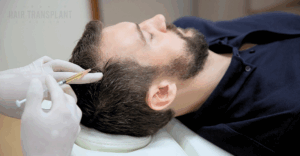Hair transplantation has emerged as a popular solution for those grappling with hair loss. In this detailed exploration, we’ll delve into the permanence of hair transplants, dissecting the procedure, its effectiveness, and long-term maintenance. As a widely adopted solution for addressing hair loss concerns, understanding the permanence of hair transplants is crucial for those considering this option. By delving into the details of the process and its implications, this analysis aims to offer valuable insights and clarity to individuals seeking effective solutions for hair restoration.
Do Hair Transplants Really Work?
Hair transplants have proven to be highly effective in addressing hair loss concerns for many individuals. This procedure involves the transplantation of healthy hair follicles from donor areas to areas experiencing hair thinning or baldness. The success of hair transplants lies in the meticulous technique used by skilled surgeons, often employing methods such as Follicular Unit Transplantation (FUT) or Follicular Unit Excision (FUE).
FUT involves the removal of a strip of scalp from the donor area, from which hair follicles are harvested and transplanted into the recipient site. FUE, on the other hand, involves extracting individual follicular units directly from the donor area and implanting them into the recipient site. These procedures rely on the body’s natural healing process to ensure the survival and growth of transplanted hair follicles.
Advancements in medical technology and surgical techniques have significantly improved the success rates and natural-looking results of hair transplants. Additionally, the ability to customize the transplant to match the patient’s hairline, density, and hair characteristics further enhances the outcome.
Understanding the Hair Transplant Procedure
The journey of a hair transplant procedure begins with the initial consultation, where the patient discusses their concerns, goals, and medical history with the hair transplant surgeon. During this phase, the surgeon evaluates the patient’s scalp condition, hair loss pattern, and donor hair availability to determine the most suitable approach.
Once the patient decides to proceed with the surgery, pre-operative instructions are provided, including guidelines for medications, alcohol, and smoking cessation to optimize the outcome and minimize risks. On the day of the surgery, local anesthesia is administered to the scalp to ensure comfort during the procedure.
The surgeon then selects the appropriate technique based on the patient’s needs and preferences, whether it’s FUT or FUE. In FUT, a strip of scalp containing hair follicles is excised from the donor area, whereas FUE involves the extraction of individual follicular units directly from the scalp.
Following extraction, the surgeon meticulously implants the harvested follicles into the recipient sites, paying close attention to the angle, depth, and distribution to achieve natural-looking results. Throughout the procedure, the surgical team monitors the patient’s comfort and safety.
Post-operatively, the patient receives instructions for aftercare and recovery, including guidelines for washing the scalp, avoiding strenuous activities, and attending follow-up appointments. Over the coming weeks and months, the transplanted hair follicles gradually take root and begin to grow, with full results typically visible within 9 to 12 months.
Factors Affecting the Longevity of Hair Transplants
An in-depth look into how genetic factors and lifestyle choices impact the longevity of hair transplants. This section will offer guidance on how to optimize the lasting effects of the procedure.
Genetic Predisposition:
The genetic predisposition of an individual plays a significant role in determining the success and longevity of hair transplants. Factors such as the pattern and rate of hair loss in the donor area, as well as the quality of the hair follicles, can influence the outcome of the procedure.
Age:
Age can affect the longevity of hair transplants. Younger patients may experience better long-term results due to potentially slower progression of hair loss and better overall healing capacity.
Hair Loss Progression:
The rate and extent of ongoing hair loss in areas surrounding the transplant site can impact the appearance of the transplanted hair over time. A thorough assessment of hair loss progression is crucial for planning the transplant procedure and managing expectations.
Hair Quality:
The quality of hair in the donor area, including its texture, colour, and thickness, can influence the aesthetic outcome of the transplant. Hair with better characteristics tends to provide more natural-looking and long-lasting results.
Health and Lifestyle:
Lifestyle factors such as diet, exercise, smoking, and stress can affect overall health and, consequently, the health of the scalp and hair follicles. Adopting a healthy lifestyle can promote better healing, hair growth, and long-term maintenance of transplanted hair.
By considering these factors, individuals can enhance the longevity and overall success of their hair transplant procedure, ensuring natural-looking results that stand the test of time.
Long-Term Results and Maintenance
Setting realistic expectations for the years following a hair transplant is crucial. This part will discuss the typical progression and what patients can do to maintain their results over time.
Regular maintenance and the potential need for touch-ups will be addressed, providing a comprehensive view of the long-term commitment required for a hair transplant.
Potential Risks and Complications
Hair transplants carry risks such as infections, bleeding, scarring, numbness, swelling, and nerve damage. Patients may also be dissatisfied with the aesthetic outcome. Patients must be fully informed beforehand to make well-considered decisions.
To mitigate these risks, patients should carefully follow pre-operative and post-operative instructions provided by their surgeon. In case complications arise, immediate medical attention is necessary. Patients should promptly contact their healthcare provider if they notice signs of infection, excessive bleeding, or any other abnormal symptoms. Addressing complications promptly can often minimize their impact and prevent further complications.
Patients need to maintain open communication with their surgeon throughout the process. Surgeons can provide guidance, support, and appropriate interventions if complications occur. Patients should also be prepared for the possibility of additional procedures or treatments to address any complications or refine the results of the initial transplant.
Overall, thorough understanding and proactive management of potential risks are essential aspects of the hair transplant process.
Conclusion
In conclusion, undergoing a hair transplant is a significant decision that requires careful consideration of both the benefits and risks involved.
By being aware of potential complications and understanding how to address them, patients can approach the procedure with confidence and preparedness. It’s essential to consult with a qualified surgeon, follow pre-operative and post-operative instructions diligently, and maintain open communication throughout the process.
Ultimately, the goal is to empower individuals to make informed choices about their hair restoration journey. By weighing the potential benefits against the risks and being proactive in managing any complications, patients can achieve successful outcomes and enhanced confidence in their appearance.





